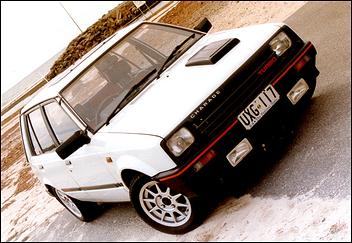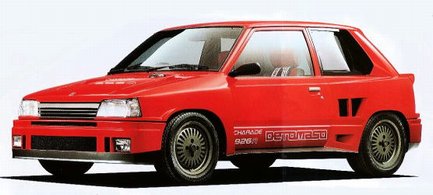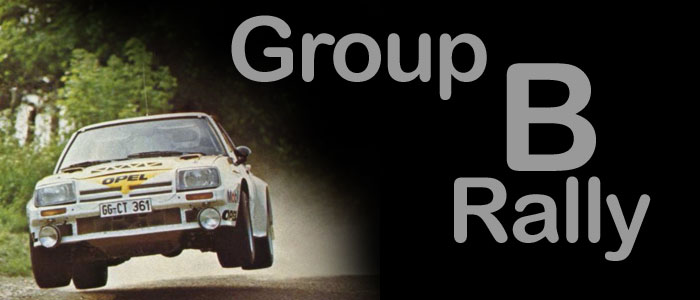Daihatsu Charade 926 Turbo

Nuove Innocenti was a well established Italian car maker who was taken over by British Leyland in 1972. From 1974 the company was now known as Leyland Innocenti and produced the Innocenti Mini, a Leyland Mini chassis and engine with a body styled by Bertone. Innocenti only lasted a year under Leyland until it was taken over again, this time by De Tomaso. The Innocenti Mini continued to be produced and by 1976 had been completely updated with plastic bumpers and larger engines and was then known simply as the Innocenti De Tomaso. The Innocenti De Tomaso proved quite a popular car and was to be manufactured without any other changes until 1982. At this point (due to ongoing supply problems with Leyland) De Tomaso looked around for a new engine supplier and eventually the original Mini chassis and engines were swapped in favour of the G11 Daihatsu Charade chassis and engines, including the CB60 SOHC 3 cylinder turbo. You could say the Innocenti Turbo De Tomaso was an excellent combination of Japanese technical knowhow with Italian 'hot hatch' style.
- Daihatsu Charade 926 Turbo (G26)
- Homologation: 01.01.1985 (B268)
- Class: Under 1300cc (926cc x 1.4 = 1297cc)
- Engine: 926cc Inline 3 cylinder (CB60)
- Head: SOHC 6 valve
- Fuel: Aisan Carburettor
- Compression: 8:1
- Induction: Forced (IHI RHB32 Turbo @ 7psi)
- Power: 75 hp
In 1983 Daihatsu started to capitalize on its relationship with De Tomaso as seen with the first generation (known as 'square eyes') Daihatsu Charade De Tomaso Turbo. The De Tomaso Turbo was based on a regular Charade Turbo but with exterior and interior changes to make it similar in appearance to the Innocenti Turbo De Tomaso. It was an advertising exercise if anything and with it's links to Italy Daihatsu took full advantage of Japanese enthusiasm for all things foreign which was booming at the time. The precursor to the 926R wasn't actually badged as a De Tomaso though. That honour was given to the Daihatsu Charade 926 Turbo which was produced for Group B Rally World Championship homologation. Only 200 of these were produced in October of 1984 and had slightly decreased engine capacity from 993cc to 926cc to fit in with sub 1300cc Group B regulations. Only a year later at the 1985 Tokyo Motor Show, Daihatsu once again showed a 'homologation special' Charade turboÖ only this time to an astonished crowd of onlookers who repeatedly asked "Is that really a Daihatsu?"
More Great Info on the Innocenti Turbo De Tomaso: www.innocenti-turbo-detomaso.com
Daihatsu Charade DeTomaso 926R

At the 26th Tokyo Motor Show in 1985, Daihatsu introduced a mid-engined homologation special for the 1986 Group B World Rally Championship season. With it's mid engine layout driving the rear wheels, front and rear blister fenders and DOHC 3 cylinder turbo engine, the 926R practically stole the show for Daihatsu. Journalists at the time quickly drew similarities with the Renault 5 Turbo which took the same approach of installing a previously front mounted engine and placing it behind the front seats for rally homologation. The 926R used the CB70 twin cam 12 valve turbo engine which was to debut in the next generation G100 Charade in 1987. With the engine mounted behind the front seats, the 926R was a dedicated two seater with with almost every panel changed in some way except for the doors and the roof. All work was done under the supervision of De Tomaso which gave the 926R a distinctly 'Latin' flavour and kept the public guessing as to the extent of the Italian automakers involvement.
- Homologation: Prototype
- Class: Under 1300cc (926cc x 1.4 = 1297cc)
- Chassis: G11
- Layout: Mid Engine (transverse), RWD
- Weight: 800kg
- Length: 3850mm
- Width: 1640mm
- Height: 1360mm
- Wheelbase: 2320mm
- Engine: 926cc Inline 3 cylinder (CB70)
- Head: DOHC 12 valve
- Induction: Forced (IHI Turbo)
- Power: 118 hp @ 6500rpm
- Torque: 109 ft/lbs. @ 3500rpm
Courtesy of a boost increase and different ECU programming, the 926R's CB70 turbo engine produced a modest power figure of 120ps @ 6,500rpm and 15.0kg/m @ 3,500rpm which was well above the 926 Turbo's unremarkable 76ps, but that wasn't such a drawback considering the 926R's weight was only around 800kg! Even with relatively low power output the Charade De Tomaso 926R was still considered by some to be Daihatsu's very own 'supercar' whether it made an impact on the Group B Rally Championship or not. The CB70 was mated to a 5 speed manual transmission and drove the rear wheels through a mechanical limited slip differential. Double wishbone suspension at all four corners with coil over type spring and damper set up gave the 926R handling to match it's rivals.
The interior was somewhat luxurious in comparison to the rest of its Group B-level specification. Grey suede and red fabric adorned the seats, dashboard and door trims with a leather bound 350mm MOMO steering wheel and gear knob. The dashboard itself was probably the biggest step away from the standard Charade Turbo, the 926R getting a custom suede covered dash with two large and six smaller Veglia branded gauges with minor switch gear for basic functions only. No audio system or A/C was available. The exterior gained the previously mentioned wide body blister fenders with air ducts for the engine situated in front of the rear wheels, a vented rear hatch to allow air flow, air ducts behind the rear quarter glass for extra air flow to the engine and huge, aggressively slanted vents on the bonnet. The wheels where supplied by Campagnolo measuring 15◊6JJ with Pirelli 205/50/VR15 tires at the front and 15◊7JJ with Pirelli 225/50/VR15 at the rear. To finish off the exterior some very Italian Vitaloni side mirrors were included as were a set of Carello fog lamps for the redesigned front bumper.

The saddest part of the 926R's story would have to be the timing of its introduction. After the extremely successful debut at the 1985 Tokyo Motor Show, Daihatsu moved to have the 926R prepared for sale with various media presentations and test drives which were all very positive; as a result great expectation was placed on its racing career seeing as its predecessor the 926 Turbo was already successful in the WRC. However, early in the 1986 Group B World Rally Championship disaster struck with a series of fatal accidents, prompting (by years end) the FIA to totally ban Group B regulations for 1987. So the production run of the 926R was canceled and it never saw the showroom. The CB70 Twincam turbo engine lived on in the 3rd generation (G100) Charade of 1987.
All info copied from: http://www.7tune.com/?p=99
